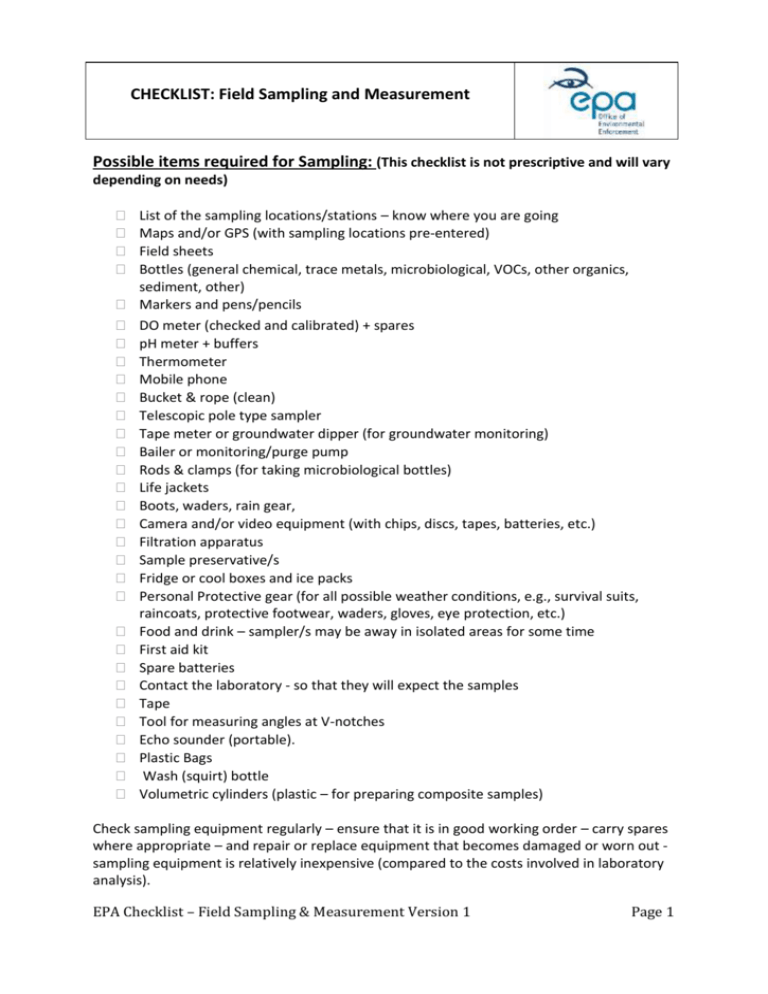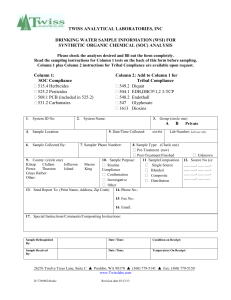Checklist on Field Sampling and Measurement, 166kb
advertisement

CHECKLIST: Field Sampling and Measurement Possible items required for Sampling: (This checklist is not prescriptive and will vary depending on needs) List of the sampling locations/stations – know where you are going Maps and/or GPS (with sampling locations pre-entered) Field sheets Bottles (general chemical, trace metals, microbiological, VOCs, other organics, sediment, other) Markers and pens/pencils DO meter (checked and calibrated) + spares pH meter + buffers Thermometer Mobile phone Bucket & rope (clean) Telescopic pole type sampler Tape meter or groundwater dipper (for groundwater monitoring) Bailer or monitoring/purge pump Rods & clamps (for taking microbiological bottles) Life jackets Boots, waders, rain gear, Camera and/or video equipment (with chips, discs, tapes, batteries, etc.) Filtration apparatus Sample preservative/s Fridge or cool boxes and ice packs Personal Protective gear (for all possible weather conditions, e.g., survival suits, raincoats, protective footwear, waders, gloves, eye protection, etc.) Food and drink – sampler/s may be away in isolated areas for some time First aid kit Spare batteries Contact the laboratory - so that they will expect the samples Tape Tool for measuring angles at V-notches Echo sounder (portable). Plastic Bags Wash (squirt) bottle Volumetric cylinders (plastic – for preparing composite samples) Check sampling equipment regularly – ensure that it is in good working order – carry spares where appropriate – and repair or replace equipment that becomes damaged or worn out sampling equipment is relatively inexpensive (compared to the costs involved in laboratory analysis). EPA Checklist – Field Sampling & Measurement Version 1 Page 1 Example of Bottles/Preservatives Required for specific analysis Sample Bottle Types used at the EPA Laboratory, Kilkenny Analysis Type Use new 1or 2 litre plastic milk bottles. 100 ml plastic Add 0.5 ml of conc. HNO3 to the 100 ml sample Volatile Organic Compounds - VOCs 40 ml glass screw-capped vials each equipped with a PTFEfaced rubber septum. Supplied pre-cleaned and sealed. Do not agitate sample prior to sealing the bottle. Fill the bottle completely to exclude all air. Semi Volatile Organic Compounds - 250ml amber glass bottles each equipped with a PTFE-faced rubber septum. Supplied pre cleaned and sealed. Do not agitate sample prior to sealing the bottle. Fill the bottle to within 1 cm of the top. 500 ml plastic bottles – each containing 50 mg of sodium thiosulphate Pre-sterilised – each bottle has a small red label that confirms exposure to radiation. Leave ≈ 2.5 cm air space to facilitate mixing before examination. 250 ml plastic (no sodium thiosulphate added) Pre-sterilised. Leave ≈ 2.5 cm air space to facilitate mixing before examination. Use a separate 1-litre glass bottle (e.g. a Kilner jar that has been pre-calibrated at 1 litre). Do not sub-divide samples; if duplicate analyses are required then use a separate container for each analysis. Check with the lab re preservatives prior to sampling –Preservatives should be added in the laboratory prior to sampling. Check with the lab re preservatives prior to sampling –Preservatives should be added in the laboratory prior to sampling. General Analysis B Trace Metals C D Semi Volatiles Microbiological – For Drinking Water F Remarks 1or 2 litre plastic A E Bottle Type and Volume Microbiological – For non-Drinking Water G Fat Oil & Grease 1 litre glass H Phenols 100 ml amber with 1 ml of 10% of NaOH J Cyanide 100 ml plastic with 1 ml of 10% of NaOH A B C D E F EPA Checklist – Field Sampling & Measurement Version 1 G H J Page 2 Example of a Field Sheet Name:__________________ Licence No.______________ Sampling Location Code: Sampling Location GPS: Bottle Marking: ___________________ Sample No. Sampling Date: ___________________ Sampling Time: ___________________ Sampled by: ___________________ Duplicate Sample Contact Person: ___________________ Split Sample Temperature: ___________________°C Grab Sample Composite Sample Start Finish Date _________ ________ Time _________ Head: _________cm Flow Meter Reading _________ _________ Units: _________ Units _________ _________ V-Notch Angle: _________° Head: _________cm Weir/Flume Width: _________cm Meter Reading _________ _________ Comments: Sample Bottles Required: Tests Required: Chemical Metals fix VOC’s SVOC’s Continue overleaf if necessary pH, BOD,of COD, Suspended Solids etc... Document Example a Kone, Chain of Custody EPA Checklist – Field Sampling & Measurement Version 1 Page 3 1. Origin of Samples Samples from: _________________________________________________________________ _____________________________________________________________________________ Sampling Date: __________________________ Sampled by: ___________________________ (Signature of Sampler) LABORATORY NO.* BOTTLE MARKING SAMPLE LOCATION AND DESCRIPTION SAMPLING TIME COMMENTS TEMPERATURE °C DO % SATN. 2. Courier (This section to be completed where the courier and sampler are different persons) The samples as described above were passed from the sampler to the courier at ___________ hours on ___/___/______. Signed: ________________ 3. Receiving Laboratory ______________________ (Courier) Received(Sampler) at: _________________________________________ Laboratory at __________________ hours on ___/__/______. Signed: _____________________ _________________________ THE ORIGINAL OF THIS SHEET IS TO BE RETAINED IN THE SAMPLING LABORATORY. USE THE BACK OF THIS SHEET FOR ADDITIONAL COMMENTS, SKETCHED ETC. (Sampler or Courier) (For Receiving Laboratory) *THE LABORATORY NUMBER ID TO BE ASSIGNED ON RECEIPT AT THE SAMPLING LABORATORY EPA Checklist – Field Sampling & Measurement Version 1 Page 4









